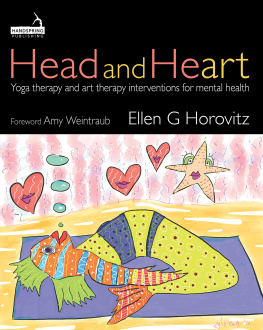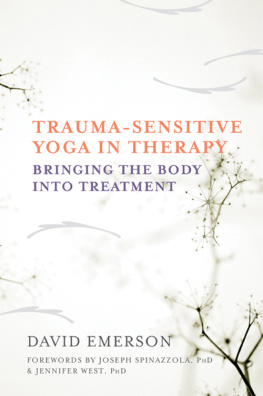Contents
Page list

of related interest
Yoga and Science in Pain Care
Treating the Person in Pain
Edited by Neil Pearson, Shelly Prosko and Marlysa Sullivan
Foreword by Timothy McCall
ISBN 978 1 84819 397 0
eISBN 978 0 85701 354 5
Yoga Therapy for Digestive Health
Charlotte Watts
ISBN 978 1 84819 354 3
eISBN 978 0 85701 312 5
Yoga Therapy for Fear
Treating Anxiety, Depression and Rage with the Vagus Nerve and Other Techniques
Beth Spindler
ISBN 978 1 84819 374 1
eISBN 978 0 85701 331 6
Yoga Therapy for Insomnia and Sleep Recovery
An Integrated Approach to Supporting Healthy Sleep and Sustaining Energy All Day
Lisa Sanfilippo
ISBN 978 1 84819 391 8
eISBN 978 0 85701 348 4
PELVIC YOGA
THERAPY for the
WHOLE WOMAN
A Professional Guide
CHERI DOSTAL RYBA
Foreword by Shelly Prosko
Illustrated by Evelyn Rosario Andry

First published in Great Britain in 2022 by Singing Dragon, an imprint of Jessica Kingsley Publishers
An imprint of Hodder & Stoughton Ltd
An Hachette UK Company
Copyright Cheri Dostal Ryba 2022
Foreword copyright Shelly Prosko 2022
Cover image Evelyn Rosario Andry 2022
All rights reserved. No part of this publication may be reproduced, stored in a retrieval system, or transmitted, in any form or by any means without the prior written permission of the publisher, nor be otherwise circulated in any form of binding or cover other than that in which it is published and without a similar condition being imposed on the subsequent purchaser.
Disclaimer: The information contained in this book is not intended to replace the services of trained medical professionals or to be a substitute for medical advice. The complementary therapy described in this book may not be suitable for everyone to follow. You are advised to consult a doctor before embarking on any complementary therapy program and on any matters relating to your health, and in particular on any matters that may require diagnosis or medical attention.
A CIP catalogue record for this title is available from the British Library and the Library of Congress
ISBN 978 1 78775 664 9
eISBN 978 1 78775 665 6
Jessica Kingsley Publishers policy is to use papers that are natural, renewable and recyclable products and made from wood grown in sustainable forests. The logging and manufacturing processes are expected to conform to the environmental regulations of the country of origin.
Jessica Kingsley Publishers
Carmelite House
50 Victoria Embankment
London EC4Y 0DZ
www.singingdragon.com
To my mother, for encouraging me to teach.
To my daughters, for joyful play and big feelings.
To everyone bravely exploring embodiment.
Contents
Acknowledgments
First, I bow to all who have received these teachings and expanded my understanding, compassion, and skill. As my students, youve been some of the best teachers. Thank you for sharing stories and celebrating victories with me.
To Laura Kupperman, for the sweet surprise of connecting me with Singing Dragon. Thank you for instigating this project! Immense gratitude to my editor, Claire, for meeting me each step of the way with enthusiasm.
To Shelly Prosko, for embracing the full spectrum of rigorous, technical accuracy, pelvic-floor jokes, compassion, personal healing youve enriched my life and this book with your presence.
For the beautiful illustrations and heartwarming friendship thank you, Eve.
To this crew for candor and providing loving feedback on drafts: Kristin, Julie, Emily, D. Chasse, Lisa, Linda, and Kelsey. I feel so grateful for close sisterhood and the broader community that holds me in positive regard. You know who you are.
To Leila Stuart, for your friendship, frank advice, and generous mentorship. I treasure you.
To Donna Farhi thank you for sharing your craft. Im honored to have observed closely as a student and assistant teacher.
To all my teachers, including: Eric Franklin; Scott Anderson; Sandra Helpsmeet, for suggesting I travel to New Zealand and sharing in practice; Susan Gingrasso, distinguished dance educator and my first client in 2003.
To past, current, and future yoga therapists in training with AlcheMe Yoga Therapy, Orange County, CA, for choosing this path. Thank you, Katie, Tess, and Megan for the joy of leading and teaching beside you as co-directors.
To my dad for his entrepreneurial tenacity and my mom for nurturing, painting, praying I found my way into work I love. To my mother-in-law for praise and presence.
Jason, my love, for participating in research and supporting my ambition. The way we partner in the dance of householding, parenting, and marriage makes me proud. To my girls may you be safe and protected, happy and free. I hope you contribute boldly to a kinder, more embodied world. Thank you for choosing us.
To my body, for the gift of exuberant life.
To nature for her solace, beauty, adventure, and rhythm.
Lastly, to peers and colleagues sharing the vision of pelvic vitality. We do this work together to liberate past and future generations. Thank you for bringing this book to life in your communities.
Foreword
Have you lost sensation in the area of your perineum, genitals, or anus, or have you had any significant problems controlling or emptying your bowel or bladder? As a physiotherapist, this is the question I was trained to ask each patient who presented with low back pain. I hoped the person would say no, otherwise it meant a red flag for cauda equina syndrome, a neurological condition that would require immediate medical attention.
That was the extent of our pelvic health training in physiotherapy a few decades ago, in addition to a few minutes of education on the importance of addressing modifications for positions during sexual intercourse for those with back pain, which was offered in the form of a pamphlet that was passed around in class briefly. Thankfully we have come a long way since then in the area of pelvic health and rehabilitation.
During the first decade of my clinical practice, research surrounding pelvic-floor health issues was growing and being translated into physiotherapy practice as a specialty area of pelvic-floor rehabilitation through professional continuing education courses. As I gained knowledge, skills, and experience, my clinical practice evolved to include helping an increasing number of people struggling with a variety of pelvic-floor issues. I am grateful to the pioneers who I have learned from and who have paved the way for us to continue to explore this path: the many researchers, educators, clinical instructors, and clinicians. However, like many specialties, the lens zooms in sharply and often does not zoom back out, resulting in a myopic view of the person and their situation. As Carolyn Vandyken, one of our pioneers in pelvic-floor rehabilitation, states, We must put the pelvic floor back in the body.
In addition to addressing the pelvic floor within the context of the rest of the body, we also need to extend beyond a postural-structural-biomechanical model and address the whole person and all of their layers of existence within the context of their environment, community, and their relationships. Due to growing and compelling evidence that can no longer be ignored, the modern-day healthcare paradigm is slowly, steadily, and thankfully shifting toward integrating a more biopsychosocial (BPS) approach in many areas of care, including pelvic healthcare. However, attempts at implementing a BPS approach often fall short, perhaps because we are immersed in a reductionistic way of thinking (the belief that individual parts simply make up the whole). If the BPS model is to be used to its fullest potential, it must be applied in a dynamic, interdependent way, in line with the complexity of the human experience.















